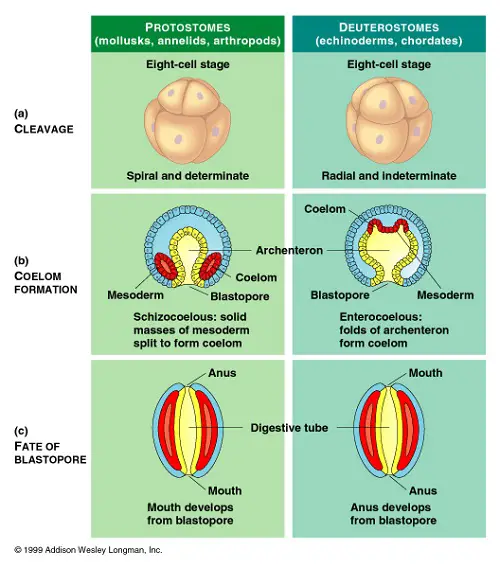
Both protostomes and deuterostomes belong to kingdom Animalia, subkingdom Eumetazoa, which consists of animals having three germ layers and bilateral symmmetry, Clade Nephrozoa. Protostomes, deuterostomes and Xenacoelomorpha are also members of clade Bilateria which is comprised of animals made up of bilateral symmetry [1]. Clade Bilateria also includes organisms like star fish and sea urchins which have bilateral symmetry at larval stages but five-fold symmetry as adults.
What are protostomes?
The word protostome comes from the Greek words “proto” meaning first and “stoma” meaning mouth. In other words Protostoma means first mouth. During the embryonic development, the protostomes first develops the mouth from the blastopore and the anus is developed after the mouth is already formed [2].
Protostome is a clade of animals that includes arthropods like crabs and insects, molluscs like snails and clams, and annelid worms. The enormous development in molecular techniques like DNA molecular sequence analysis in the last couple of decades have added another dimension to the classifications of the protostomes. The recent molecular biological techniques suggests that protostomes can be divided into two major groups or super phyla called Ecdysozoa and Spiralia. Ecdysozoa includes animals like anthropods and nematodes whereas spiralia includes molluscs, annelids, platyhelminths and votifers [3].
What are deuterostomes?
The word Deuterostoma comes from two Greek works “deutero” meaning second and “stoma” meaning mouth. In other words, deuterostomes means second mouth. In deuterostomes, the blastopore or the opening at the bottom of the forming gastrula becomes the anus. The mouth is formed in the later stages of embryonic development. In the deuterostomes, mouth and anus are at the opposite ends of the blastopore, and the digestive track connecting the two eventually develops in the middle.
The deuterostomes are further classified into three major clades, Chordata, Echinochordata and hemichordate. The clade Chordata consists of all vertebrates such as birds and mammals including human beings. The last two clades consists of invertebrates. Clade echinodermata includes sea urchins, star fish and sea cucumbers. The last major clade, hemichordata includes acorn worms and grapholites.
DNA molecular sequence analysis removed the lophophorates from super phylum Deuterostoma and placed it with other protostomes and formed super phylum lophotrochozoa [4], [5].
What are the major differences between protostomes and deuterostomes?
The most important difference between protostomes and deuterostomes are due to the differences in the embryonic development. In protostomes, blastopore develops into mouth whereas in deuterostomes, the blastopore develops into anus. The other major differences between the protostomes and deuterostomes are listed below.
- Origin of mesoderm
The rudimentary alimentary cavity formed during the early stages of embroyogensis is called archenteron. This archenteron develops into mesoderm and endoderm of a living organism. The protostomes do not have an archenteron development whereas deuterostomes have this primitive gut formation in the early embryos.
- Later development of gut
In protostomes, the gut is tunneled into the embryo and forms anus whereas in deuterostomes the mouth is formed by the gut tunneled into the embryo
- The coelom development
The protostomes are schizocoelomates, that is, the coelom is formed through the process of schizocoely. The coelom or body cavity is formed by the splitting of the mesodermal tissue. In deuterostomes, on the other hand, the coelom forms through the process of enterocoely. In this scenario, the body cavity is formed when the mesoderm pinches off from the digestive tract or gut.
- The type of cleavage
The protostomes undergo determinate cleavage. Determinate cleavage means that the blastomere produced in the early embryonic stage do not have the capacity to develop into independent embryos. The deuterostomes, on the other hand undergo indeterminate cleavage. This means that all the early blastomeres have the capacity to develop into a complete embryo.
- The development of blastopore
In protostomes the blastopores develop into mouth whereas as in deuterostomes the blastopore is believed to develop into anus.
- The type of holoblastic cleavage
The protostomes undergo spiral cleavage. In spiral cleavage the blastomeres of the animal pole are rotated with respected to those of the vegetal poles. Deuterostomes on the other hand, undergo radial cleavage. In radial cleavage, the blastomeres of upper tiers are positions directly above those of lower tiers. This results in radial symmetry across animal pole and vegetal pole.
- The nervous system
The nervous system in protostome is solid, ventral nerve cord. Whereas in deuterostomes, the nervous system is composed of hollow nerve cord. Many deuterostomes also have pharyngeal gill slits.
- Origin of mouth and anus
In protostomes, the anus rises secondarily whereas in deuterostomes the mouth rises secondarily.
- Protostomes contains more phyla and species than the deuterostomes.
- Deuterostomes are more evolved and complex in their body compositions than protostomes.
- Protostomes can be priapulids whereas dueterostomes are always enteroceolus.
- There are multi-ciliated cells in protostomes whereas the deuterostomes are all mono-cliated.
- Deuterostomes mainly includes echinoderms, hemichordates, and chordates, whereas all the remaining bilaterian phyla is grouped into protostomes or be divided into two groups: protostomes and lophophorate.
- Protostomes primarily includes flat worms, annelids, arthropods, molluscs and some other less complex organisms Whereas Deuterostomes include echinoderms, chordates, pogonophora, hemichordates and other higher and more complex organisms. The deuterostomes includes higher animals like human beings, monkeys, birds etc.
The major differences between Protostomes and Deuterostomes are mentioned above. These differences are listed below in a tabular form.

Conclusions
The main difference between the protostomes and deuterostomes is due to the fate of the blastopore during embryonic development. In protostomes, the blastopore develops into mouth first and then the gut is tunneled and forms anus. On the other hand, in the deuterostomes, the blastopore forms anus first and eventually the mouth is formed. The protostomes have spiral cleavage and the deuterostomes have a radial cleavage in the initial stages of embryonic development. Moreover, the protostomes have determinant cleavage and the deuterostomes have none. Furthermore, the protostomes are less complex organisms and do not have a hollow nerve cord like higher mammals whereas the deuterostomes include the higher mammals including human beings and have a complex and well developed nervous system.
Author: Debashree Basu
Debashree received her PhD in Biochemistry and specialized in infectious diseases. She is a Research Scientist whose main focus is bacteria, yeast and mammalian cells. She published articles in peer reviewed journals.

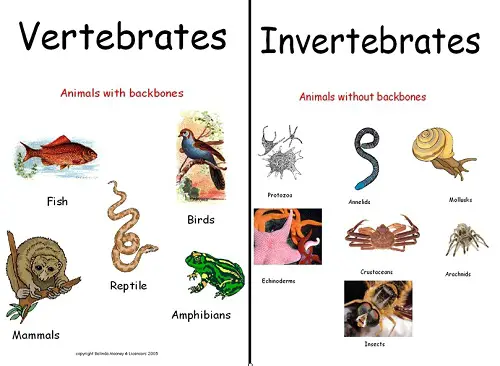
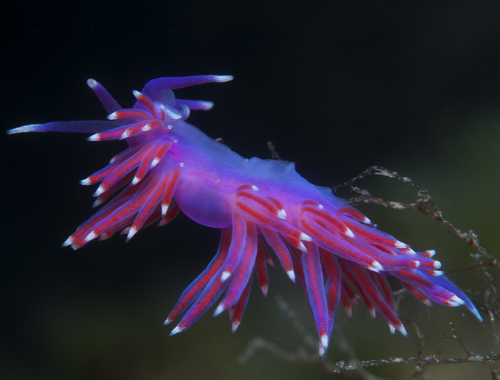

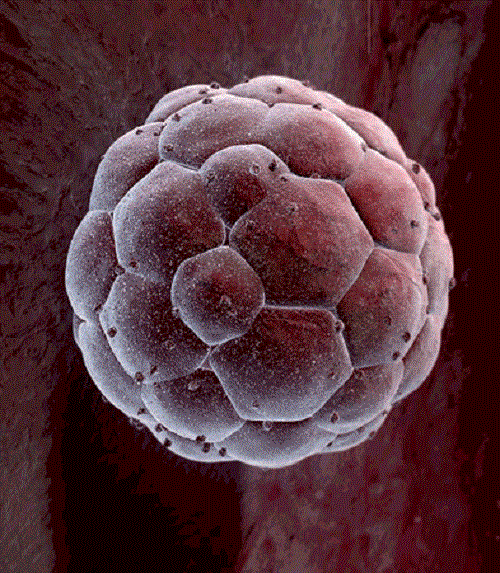
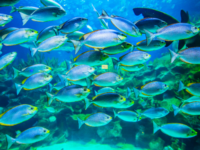
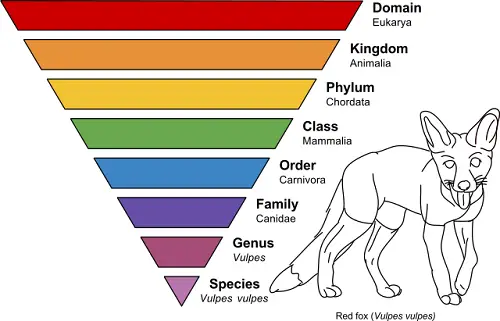





Leave a Reply